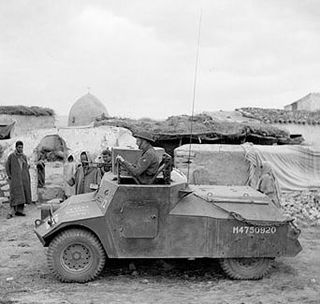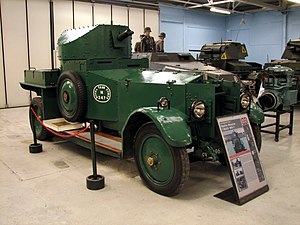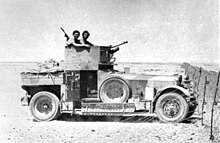
A military armoredcar is a lightweight wheeled armored fighting vehicle, historically employed for reconnaissance, internal security, armed escort, and other subordinate battlefield tasks. With the gradual decline of mounted cavalry, armored cars were developed for carrying out duties formerly assigned to light cavalry. Following the invention of the tank, the armored car remained popular due to its faster speed, comparatively simple maintenance and low production cost. It also found favor with several colonial armies as a cheaper weapon for use in underdeveloped regions. During World War II, most armored cars were engineered for reconnaissance and passive observation, while others were devoted to communications tasks. Some equipped with heavier armament could even substitute for tracked combat vehicles in favorable conditions—such as pursuit or flanking maneuvers during the North African Campaign.

The FV 214 Conqueror, also known as Tank, Heavy No. 1, 120 mm Gun, Conqueror was a British heavy tank of the post-World War II era. It was developed as a response to the Soviet IS-3 heavy tank. The Conqueror's main armament, an L1 120 mm gun, was larger than the 20-pounder (83.4 mm) gun carried by its peer, the Centurion. The Conqueror's role was to provide long range anti-tank support for the Centurion. Nine Conquerors were issued for each regiment in Germany, usually grouped in three tank troops. In the British Army both the Conqueror and the Centurion were replaced by the Chieftain.

The Humber Armoured Car was one of the most widely produced British armoured cars of the Second World War. It supplemented the Humber Light Reconnaissance Car and remained in service until the end of the war.

AEC Armoured Car is the name of a series of British heavy armoured cars built by the Associated Equipment Company (AEC) during the Second World War.

The Fox Armoured Car was a wheeled armoured fighting vehicle produced by Canada in the Second World War.

The Marmon-Herrington Armoured Car was a series of armoured vehicles that were produced in South Africa and adopted by the British Army during the Second World War. RAF Armoured Car companies possessed them, but seem never to have used them in action, making greater use of Rolls-Royce Armoured Cars and other types.

The Humber Light Reconnaissance Car, also known as Humberette or Ironside, was a British armoured car produced during the Second World War.

Morris Light Reconnaissance Car (LRC) was a British light armoured car for reconnaissance use produced by Morris Motors Limited and used by the British during the Second World War.

Standard Car 4x2, or Car Armoured Light Standard, better known as the Beaverette, was a British improvised armoured car produced during the Second World War.

The Lanchester 6x4 armoured car was a British armoured car with a 6x4 drivetrain produced in limited numbers in the late 1920s and early 1930s. A heavier, more rugged development of the earlier Lanchester 4x2 armoured car, it remained in service with Territorial and colonial units until the early 1940s and saw action in the Battle of Malaya.

The Lanchester armoured car was a British armoured car built on the chassis of the Lanchester "Sporting Forty", it saw wide service with the Royal Naval Air Service and British Army during the First World War. The Lanchester was the second most numerous World War I armoured car in British service after the Rolls-Royce armoured car.
This article lists British armoured fighting vehicle production during the Second World War. The United Kingdom produced 27,528 tanks and self-propelled guns from July 1939 to May 1945, as well as 26,191 armoured cars and 69,071 armoured personnel carriers.

During the First World War, sixteen American Peerless trucks were modified by the British to serve as armoured cars. These were relatively primitive designs with open backs, armed with a Pom-pom gun and a machine gun, and were delivered to the British Army in 1915. They were used also by the Imperial Russian Army as self-propelled anti-aircraft guns.
The Number 2 Armoured Car Company RAF was a military unit of the British Royal Air Force (RAF) which was based at Amman in what was then called the Transjordan. It was the counterpart of No.1 Armoured Car Company RAF, which performed a similar role in Iraq.

Throughout its history, the Irish Army has used a number of armoured fighting vehicles.

Cavalry Tank Museum is a military museum in Ahmednagar in the state of Maharashtra, India. It was established by the Armored Corps Centre and School in February 1994. It is the only museum of its kind in Asia and houses about 50 exhibits of vintage armored fighting vehicles.

The Delaunay-Belleville armoured car was a British armoured car built on the chassis of the luxury French Delaunay-Belleville tourer. It saw service with the Royal Naval Air Service in the early years of the First World War.

The Seabrook armoured lorry was a British heavy armoured car built on the chassis of an American 5-ton truck which saw service with the Royal Naval Air Service during the First World War.

The Pierce-Arrow armoured lorry was a heavy armoured car mounting a QF 3-pounder Vickers gun, it was used by the Royal Naval Air Service during the First World War.

The Talbot armoured car was a British armoured car built on the chassis of a Clément-Talbot tourer. Built in small numbers to several patterns, the Talbot armoured cars saw service with the Royal Naval Air Service (R.N.A.S.) in the early years of the First World War, serving alongside Rolls-Royce and Delaunay-Belleville armoured cars.





















